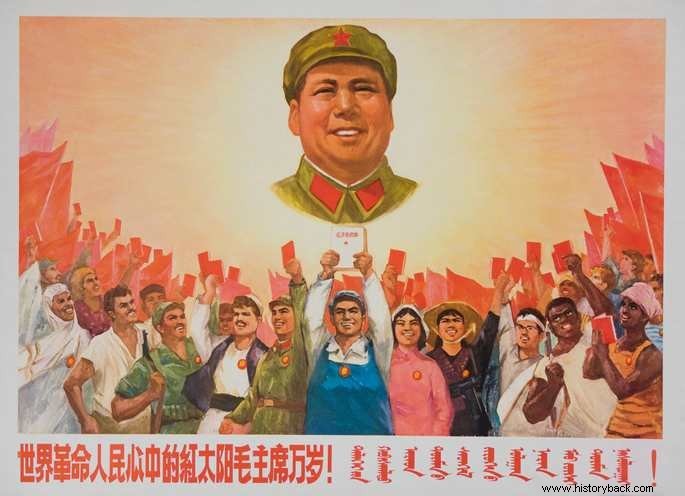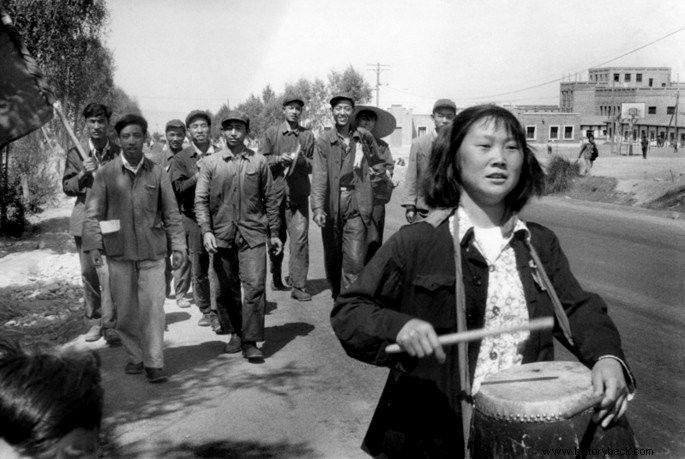The Great Proletarian Cultural Revolution, known as the Revolution Chinese Cultural, it was a political cleansing movement spearheaded by Mao Zedong.
Its objective was to remove elements considered bourgeois or capitalist from the ranks of the Communist Party of China.
It is estimated that the Chinese Cultural Revolution left 1 million dead.
Mao Zedong and the Cultural Revolution

In the late 1950s, Mao Zedong tried to make China an industrialized country. To do so, he launches the "Great Leap Forward" plan, which turns out to be a failure.
In order to stay in power and ward off opponents, Mao is preparing an offensive that will mobilize urban strata, especially students.
For this, he launches a regeneration campaign and calls on the population to fight the "Four Old Ones":old thoughts, old culture, old customs and old habits, which should be replaced by the ideas of the communist leader.
The working and peasant classes were exalted and everything related to culture and intellect was rejected. Gathered in the "Red Guard", students denounced their teachers, destroyed monuments and burned literary works.
The Chinese Cultural Revolution was guided by the work "The Little Red Book", which brought together thoughts and quotes from Mao Zedong. The book has become mandatory in schools, the army and all Chinese institutions.
Several professors, politicians and intellectuals were accused of being bourgeois and capitalist. In this way, they were sent to the countryside or factories to be "re-educated" in communist values.
Likewise, Mao undertook a cult of his personality where he was called the "Great Helmsman". He would be responsible for leading the Chinese people to prosperity, without counting on popular participation.
The consequences of the Cultural Revolution were tragic:thousands of works of art lost, about a million people murdered, imprisoned and removed from their professional activities. For Mao, however, the movement secured his position within the country and within the Communist Party of China.
The Cultural Revolution officially ended in 1969, but many historians claim that it only ended with Mao's death in 1976.
See also:Greatest Dictators in HistoryThe Great Leap Forward and the Cultural Revolution

The Great Leap Forward (or Great Leap Forward) was a policy of forced industrialization initiated in 1958 by Mao Zedong.
The aim was to transform China, from a populous and agrarian country, into an industrial nation in a short time. For this, Mao employs the same methods that Stalin did in the Soviet Union:forced collectivization of land, displacement of populations and abandonment of agricultural activity.
The result was disastrous:at that time, China did not industrialize as expected, crops were abandoned, and the consequence was widespread famine that may have killed 38 million people.
In the face of such chaos, Mao Tse-Tung's position was weakened and there were already several dissenting voices within the party itself calling for more political participation. Mao then decides to launch the Chinese Cultural Revolution in order to win the support of the youth.
See also:CommunismOrigin of the Chinese Cultural Revolution
After the end of World War II (1939-1945), the world was divided into two distinct political and economic zones:capitalism and communism. This period went down in history as the Cold War and was a time of political-military tension.
China, in 1949, under the leadership of Mao Zedong, chose the socialist path and aligned itself with the Soviet Union, then led by Josef Stalin.
The Asian continent would still be the scene of a bloody conflict that would forever divide the Korean peninsula:the Korean War (1950-1953). North Korea, which borders China, became communist and became an ally of that country.
Precisely, in the 50s, there was a change of power in the Soviet Union. Stalin dies and is succeeded by Nikita Khrushchov (1894 -1971). He denounces various crimes committed by Stalin and communicates his intention to make adjustments to the Soviet regime.
Disillusioned, Mao Zedong turns away from his former ally and decides to carry out his own economic and political revolution in China.
A new stage in Chinese politics begins and the elaboration of a specific communist path, Maoism. This political ideology would influence various political movements around the world.
See also:Cold War:features, causes and consequencesFun facts about the Chinese Cultural Revolution
- The Cultural Revolution hit the Beijing Opera which had all its sets and costumes destroyed.
- Religion was also considered something bourgeois and several monks were expelled from the country, as well as Christian churches were eliminated.
- In 1981, the Chinese government assumed that the Cultural Revolution had been a big mistake and apologized to the people.
Don't stop here. There are more texts from Toda Matéria on this subject :
- Differences between Communism and Socialism
- China
- Chinese Culture
- USSR
